Arts & Culture
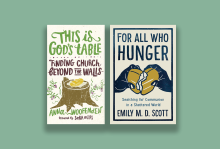
LONG BEFORE the coronavirus inspired congregations to gather outside of a sanctuary, Emily M.D. Scott and Anna Woofenden birthed congregations (St. Lydia’s Dinner Church in Brooklyn, N.Y., and the Garden Church in San Pedro, Calif., respectively) that shed pageantry and focused on the basics: bread, cup, and looking-a-person-deep-in-the-eye connection.
Around a dinner table and in an urban garden, these two scrappy congregations grew through environmental disasters (Hurricane Sandy and a multiyear California drought), confrontations with external and internal classism and racism, and the joys and griefs of bringing a new vision of ekklesia into the world.
It is rare to see the tangled roots of a church plant. Yet, both authors share insecurities about failed worship services, unstable budgets, and the long loneliness that comes with church leadership. The vivid character development, precise detail, and theological depth of both narratives make the reader feel at home in the possibility of worship beyond pew-lined sanctuaries.

IN THE NOVEL Transcendent Kingdom, Gifty is a doctoral candidate in neuroscience at Stanford University, aiming to identify the neural pathways that suppress reward-seeking behavior. She is at the lab trying to keep two mice from tearing each other apart when her mother’s pastor calls. Gifty’s mother is sick, severely depressed ever since her son, Gifty’s brother Nana, died of a heroin overdose. Now, years later, Gifty wants nothing more than to bring her mother back to life.
In her second book, author Yaa Gyasi continues to grapple with familial loss and inheritance. But while her debut novel Homegoing examined the legacy of slavery, Transcendent Kingdom follows a young woman as she recalls her immigrant family’s triumphs alongside their devastating fight with depression and addiction. Through her methodical (scientific, spiritual, and philosophical) inquiry, Gifty tries to keep their memories alive.
What happens when the past haunts and overwhelms the present? At 28, Gifty’s life is lonely lab work and rumination, a mother unresponsive save for her hum, a father so distant he is not called by name. Even when Gifty is silent, the past reverberates loudly in her relationships. If she can find answers to her research questions, perhaps one day someone could be saved from the throes of addiction. But who will save her?

THE PAST DECADE has seen an endless trickle of negative stories about social media—data breaches, Russian bots, cyberbullying, digital radicalization, etc.—so by now almost everyone knows that the amusement and convenience those platforms offer come with a downside. But now a new Netflix documentary, The Social Dilemma, is here to tell us one big thing: It’s worse than we thought. In fact, it’s worse than we could have possibly imagined.
In the film this alarm is raised by many of the very people who helped create the systems they now decry. We’re talking about the guy who invented the “Like” button for Facebook, the guy who designed the recommendation engine for YouTube, the fellow who invented the infinite scroll. One after another these mostly white, mostly male characters come on camera to tell us how badly their proudest accomplishments have gone awry.
The big problem these folks warn us about is that our smartphones constantly collect data (what we buy, what music we play, where we are, who we talk to, etc., ad nauseam) and that data is used to fuel a system of targeted alerts, notifications, and recommendations designed to keep us on a site for as long as possible and deliver us to advertisers who also have that data about us.
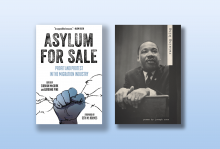
Wonderfully Made
Phillip Picardi, former editor of the LGBTQ magazine Out, looks into the intricacies of religion in his podcast Unholier Than Thou. From harsh treatment of Muslims by U.S. Immigration and Customs Enforcement to exploring the sacred role of trans people in some religious traditions, Picardi calls for good-hearted faith. Crooked Media.
Shall Not Be Sold
Appallingly, around the world many people are making money from grueling asylum processes. Asylum for Sale: Profit and Protest in the Migration Industry, edited by Siobhán McGuirk and Adrienne Pine, assembles words of resistance from journalists, activists, academics, and especially asylum seekers proposing more humane visions of asylum. PM Press.
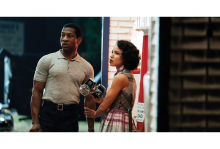
EVERYTHING THAT THE devil stole, HBO’s giving back to me. That’s a sacrilegious statement, but sometimes that’s how I feel when I’m on my couch watching yet another show with a largely Black cast (and sometimes even crew) miraculously greenlit in a sea of Hollywood whiteness by the network titan that years ago gave us The Wire and made many of us notice the likes of Idris Elba.
For what seemed like eons to Black folks eager for visual confirmation that their lives mattered, Black characters on TV were mostly relegated to sidekick or background roles—and Black writers, directors, and showrunners were rare or entirely absent. But from Insecure to A Black Lady Sketch Show, Watchmen to I May Destroy You, HBO is perhaps the strongest ally for revolutionary Black artists and creators of color on and behind TV.

IT'S ALMOST DECEMBER, and in a few weeks we may gather with our families (potentially via Zoom) to sing “Away in a Manger” and “Hark! The Herald Angels Sing.”
Each of these songs depicts baby Jesus in a different way, from a poor, defenseless child to a newborn king. Each contributes to our faith in a different way. That tiny baby reminds us of Jesus’ humanity and his solidarity with the poor, while the incarnated Lord reminds us of God’s splendor and glory.
From these hymns to the latest Hillsong chorus, most songs about Jesus have been written by Christians for their fellow believers. Over the past 50 years, however, this has changed. Songs about Jesus no longer show up just in church, but also in discos, honky-tonks, blues bars, and strip clubs. Over the past 50 years, Jesus has appeared in hundreds of songs in every secular genre. These artists explore in their own unique ways the question that Jesus asked his disciples: “And who do you say that I am?”
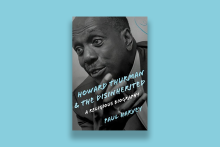
FROM HOWARD THURMAN'S own account, his grandmother, in particular, fundamentally shaped his religious sentiments; she was his hero. His grandmother had been a slave, and later, when Thurman began writing his books on the spirituals, he had her words in mind. Nancy was also a midwife in Daytona, known generally by the community as “Lady Nancy,” and remembered by Thurman as the “anchor person in our family.” She came from a large plantation estate in South Carolina; her owner, John C. McGhee, had moved to Madison County, Florida, before the war, where the majority of the larger planters were from South Carolina. Growing up, Thurman made frequent pilgrimages to Madison County but remembered of his grandmother, “She granted to no one the rights of passage across her own remembered footsteps.”
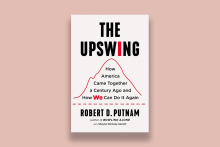
IN THIS TIME of pandemic and sheltering in place, we all feel the need for community. We self-isolate to guard the health of ourselves and our friends—shunning our neighbors is, paradoxically, loving them. This cultural conundrum suits our individualistic age, and the story of how we came to this rampant individualism is told in The Upswing: How America Came Together a Century Ago and How We Can Do It Again, by Robert D. Putnam and Shaylyn Romney Garrett.
Putnam made his name 20 years ago with Bowling Alone, diagnosing America’s shrinking sense of community since the ’60s. He propagated the concept of “social capital” to name the value of our connections, to quantify our losses. Now, in The Upswing, he takes the story back further and speaks in simpler terms of “I” and “we.”

JOHN LEWIS died the week I read this book. No American alive in 2020 was a better witness to the courage of nonviolent civil disobedience than Lewis. Ironically, that same week “warriors” from the federal government descended, uninvited and unidentified, on Portland, Ore. Violence exploded. The Bible’s final book, Revelation, seems more relevant than ever.
Thomas B. Slater’s slim volume is not a typical commentary on the biblical book, analyzing all its chapters and decoding all its symbols. Instead, Slater focuses on the political situation of seven small house churches in Roman-dominated Asia Minor (now western Turkey), to whom John of Ephesus wrote (Revelation 2-3). These believers lived in cities where temples or shrines represented the imperial cult, and all subjects were expected to offer sacrifices to the current “divine” emperor.
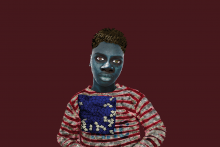
IF YOU EXPECT a column about art, you may have turned to the wrong page. Though I would very much like to be writing about aesthetics, I’m afraid I cannot do so outright. The problem is simple: Our world is on fire, has been for a very long time, and we can no longer afford to avoid the why. Our country looks in the mirror and cannot recognize its face because its self-concept is built on lies. To be an American, it seems, is to be in a state of constant dissociation. Perhaps that is the fine print in our social contract—mandated distance from our inner worlds and the violence we inflict on each other.
But, if we are constantly looking away from ourselves, what are we looking at instead? The answer is, again, simple. We—this “we” primarily composed of white people—have traded a clear vision of reality away for the tawdry allure of images. Put frankly, we worship a portrait of America that has not yet come into being.

A Thousand Freedoms
The film A Thousand Cuts profiles journalist Maria Ressa, who has worked to hold Philippine President Rodrigo Duterte accountable for his authoritarianism. Documentary filmmaker Ramona S. Diaz captures Ressa’s fight against suppression of the press and the people’s struggle against a deadly man. PBS Distribution.

ONE OF THE MOST important things art—especially narrative art—can do is inspire us to show empathy for others by making us see the world through someone else’s eyes. Stories of kindness and compassion are stories of the gospel in action. Right now, in a time of extreme division, conflict, and isolation, we need stories that remind us what that looks and feels like, and the ways in which we can show it to others.
Chilean filmmaker Maite Alberdi’s documentary The Mole Agent is a heartwarming testament to this type of kindness. Alberdi’s film follows 83-year-old Sergio, hired by a private detective to go undercover at a nursing home and report on the treatment of its residents. Sergio’s loving interactions with everyone he meets and Alberdi’s observational filmmaking together provide an example of love through serving others.

RETIREES RICHARD AND LISA Starling are Georgia natives turned Cornell academics; their son Michael and his wife, Diane, are barely getting by in Texas; their son Thad and his boyfriend, Jake, live comfortably in Brooklyn. These family members voted for different candidates. Their experiences of religion range from solace to trauma, they have an unwritten list of topics they don’t discuss, and it takes tragedy and close confines to break open their surface-level peace and push them into the conversations they’ve been avoiding.
These characters appear in David James Poissant’s latest novel Lake Life, which is set in 2018 but explores family dynamics that feel especially relevant in 2020. Jen Hinst-White spoke with Poissant in late July, five months into COVID-19 social distancing, two months after George Floyd’s death and the resulting groundswell of protest, and three months before the national election.
Jen Hinst-White: You could have written a straightforward family drama, but your characters’ personal struggles also pull in big questions of theology, culture, and politics. Why?
David James Poissant: Those things grew important to me in my writing life because they’re important to me in my real life. I’m bad at acquaintanceships. As soon as I meet someone, I want to talk to them about God and their childhood and “Do you go to therapy?” I can’t write about family without writing about place, and I can’t help considering the politics and environment of the places I’m writing. Do these people believe in God, and in what way? And how do their beliefs affect their worldview? In an alternate universe, I’m probably a sociologist.

A FEW YEARS ago, an acquaintance and I found ourselves debating the value of art in a capitalist society—a suitably light topic for a summer evening. My companion believed strongly that art must explicitly denounce the world’s injustices, and if it did not, it was reinforcing exploitative systems. I, ever the aesthete, found this stance reasonably sound from a moral perspective but incredibly dubious otherwise.
Then, as now, I consider art’s greatest function to be its capacity for expanding our conceptions of reality, not simply acting as moralistic propaganda. After all, the foundational thing you learn in art history is that the first artists were mystics, healers, and spiritual interlocutors—not politicians.
We started making art, it seems, to cross the border between our world and one beyond. Prehistoric wall paintings of cows and lumpy carvings of fertility goddesses serve as the earliest indications of our species’ artistic inclinations, blurring the lines between religious ritual and art object. Even as the world crumbles around us, I am convinced we must hold onto art’s spiritual properties rather than succumbing to the allure of work that only addresses our current systems.
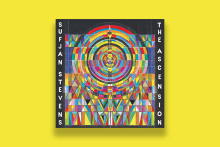
The album is titled The Ascension but, I’ve got to be honest, Sufjan Stevens’ latest masterwork has me feeling the lowest I’ve felt about this country since the start of quarantine.

Anne Helen Petersen is a writer and journalist based in Missoula, Mont. She recently left BuzzFeed, where she was senior culture writer, and now runs the Substack newsletter “Culture Study.” In her new book, Can’t Even: How Millennials Became the Burnout Generation, Petersen dives into the systems and culture that have driven the generation’s need for constant productivity that led to burnout. In her latest newsletter, she focuses on the contours of clergy burnout.
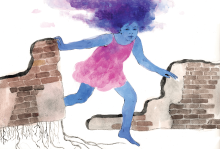
Call this hair crazy.
but watch as it grows
outside of your gates
and beyond the walls
you’ve made to contain
me. See as it reaches
higher than anything you
ever thought of me,
shedding every lie of
inferiority.
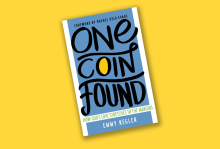
THIS IS NOT merely a survivor’s memoir; it is a grab-your-Bible-and-learn book; it is a love letter to God and the author’s queer family. In her prologue, “Lost,” Emmy Kegler sets out her agenda: “I want to tell you about the lost chapter of the Bible, the one with the story of a shepherd who leaves 99 sheep behind and goes out looking for the one that is lost. The one with the story of a woman who sweeps her entire house looking for the one coin that is lost. The one with the lost son who wanders from home and a lost son who stays and stews in his resentment and a lost father struggling to unite his broken family.”
In her first of many footnotes, Kegler identifies Luke 15:1-32 as that “lost” chapter. She spends the rest of her book conveying God’s expansive love for all who are deemed lost.
Kegler focuses on details of her story, about how bewildering it was to discover she was gay during the AIDS pandemic, in the year after Matthew Shepard’s murder. She observes, “Perhaps this is why I was fascinated by Jesus’ death: I saw the experience of my own people reflected in it.” In another chapter, Kegler recounts the pain of attending a church youth group for two years, with the leadership ultimately asking her to “pray the sinner’s prayer” when she revealed her sexual orientation.

WHILE THE CLIMATE crisis has reconfigured our relationships with each other, other creatures, and our places, fiction has not. It remains focused on the human’s internal, moral journey, as if human life is something circumscribed from the rest of creaturely life. Gun Island is a much-needed antidote to the anthropocentric ideal of the novel, one that meets the age of climate change with stories that are true to the new dimensions of relationships unfolding around us.
In his first novel since his nonfiction masterpiece The Great Derangement, in which he laid out a vision for a climate-changed literature, Ghosh illustrates the agency of nature: how in this Anthropocene age, shaped by human activity, our porous lives are intertwined with those of our nonhuman interlocutors, who become increasingly present in our lives through climate-change-driven typhoons, fires, and species migration. He tells a story of stories, not recasting the tales of modernity, but reaching back into Bengali folklore to guide us through this uncanny age. For, as one of Gun Island’s characters says, “Only through stories can invisible or inarticulate or silent beings speak to us; it is they who allow the past to reach out to us.”

HERE WE LEARN from the ghost of Marvin Gaye, question the ethics of Nikola Tesla, examine the character of God, and drift in lament and wonder.
In these poems by Hanif Abdurraqib, violence appears in different forms. In some lines, it is a fistfight between teenagers in a schoolyard, in others the anti-Blackness of a suburb or the music industry: “[T]he mailman still hands me bills like I should feel lucky to have my name on anything in this town,” Abdurraqib writes.
Thirteen of the 51 poems are titled after a criticism he heard from a white woman at a poetry reading in 2016: “How can black people write about flowers at a time like this?”